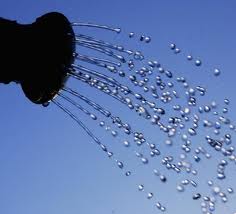Watering Cannabis Plants
Water provides hydrogen for the cannabis plants’ growth along with carrying nutrients throughout the plant during transpiration.
The amount of water and how often to water the plants varies, depending upon different factors; The size of the plants, the pots, the type of soil, temperature, humidity and air circulation are just a few variables, but overall watering your cannabis plants is mainly common sense and here are a few facts and pointers.
 During germination keep the soil surface moist and warm, as discussed in the germination section, but once the baby seedlings are established, let the top layer of soil dry out before watering again. This helps to prevent any chance of stem rot. Try to water around the stems rather than directly on them to prevent the force of the water from knocking them over.
During germination keep the soil surface moist and warm, as discussed in the germination section, but once the baby seedlings are established, let the top layer of soil dry out before watering again. This helps to prevent any chance of stem rot. Try to water around the stems rather than directly on them to prevent the force of the water from knocking them over.
In general, throughout the growth, when the soil about two inches deep feels dry, water so that the soil is evenly moist but not too much that water runs ‘heavily’ out of the drainage holes and carries away all the nutrients with it. Well-draining soil ‘will’ allow some water to run through it. After a few waterings, you will soon get an idea as to how much water your pots will hold. Some people judge this using the lift-the-pot method, i.e. simply judging how heavy the pot is when needing watering which they then use as their guide.
Over-watering is probably the most common problem for inexperienced growers as the one bit of knowledge they often have is “plants need water!” Cannabis plants prefer a regular watering cycle, but should rarely be watered every day. A large pot that was saturated during germination may hold enough water for the first couple of weeks of growth. Using common sense it is clear that a six-foot heavy drinking plant in a 5-litre pot will have to be watered far more regularly than a 2-foot plant in a 20l pot. Always water enough to moisten the soil all the way through, don’t just wet the surface layer.
Cannabis plants do not like constantly saturated soil. Plants grown in constantly wet soil are slower-growing, have less potency, and are more prone to stem or root rot.
Underwatering is less of a problem since it is easier to recognise for many people. When the soil becomes too dry, the plant starts to wilt. Plant cells are kept rigid by the pressure of their cell contents, which are mostly water. With the water gone, they collapse.
First, the bottom leaves droop, and the condition quickly works its way up the plant until the top itself gets droopy. If this should happen then water immediately, they can still recover well. Some strains will survive for several days in this condition and recover with the watering, tho yields will quite likely be affected.
The typical cannabis grower will water approximately twice a week, so, don’t keep the pots constantly wet, and don’t wait until the plant is drooping. Work to a wet n dry cycle, allowing the soil to almost dry out before watering again. Not bone dry tho, soil that is too dry will not absorb the water properly which in turn means no nutrients being passed around the plant properly too.
If you find that your pots have dried out a little too much, add a little amount of washing-up liquid to the water, this will help the soil absorb the water. Use room temp water it is absorbed easier and also prevents the shock that cold water might bring. Try to water during the plant’s morning hours if possible and don’t leave the pots sitting in water, use pebbles or clay balls or something to prevent this.
Just regular tap water?
I have no problem suggesting people use tap water despite some people suggesting to use filtered or RO (reverse osmosis) water. Tap water in different areas will differ sure and sometimes some tap water might be very high in Chlorine. Over the years we have found no major problems caused by slightly higher Chlorine, it might lock out some micronutrients here and there but in most cases, simply leaving the tap water out for a few hours before using it to water the plants will allow most of this Chlorine to dissipate.
Hard tap water usually contains a number of minerals, like Ca, Mg and K which are essential nutrients to plants. Water softeners remove these minerals by replacing them with sodium, which forms slightly salty water. It is preferable if you have a choice to water with hard water.
It is not true that the more water given a plant, the faster it will grow. Certainly, if a plant is consistently under-watered, its growth rate will be slower.
Paz’s Conclusion
Experience and common sense prevail. Environment, genetics, pot size etc all play a role so there is no set amount or schedule. Know your plants!
FAQs
Q: How often should I water my cannabis plants?
A: The watering frequency depends on various factors such as the plant’s growth stage, environmental conditions, and the moisture level of the soil. It’s essential to monitor the soil moisture and water only when necessary to prevent overwatering.
Q: Can I reuse the water runoff from my cannabis plants?
A: Reusing water runoff can be a sustainable practice. However, it’s crucial to monitor the nutrient levels and pH of the collected runoff water to ensure it doesn’t negatively affect the plants.
Q: Are automated watering systems effective for cannabis cultivation?
A: Yes, automated watering systems can be highly effective in cannabis cultivation. These systems provide precise control over watering, ensuring optimal moisture levels and reducing water wastage.
Q: How can I prevent water evaporation from the soil?
A: Mulching is an effective technique to prevent water evaporation from the soil. By applying a layer of organic mulch around the plants, you can conserve soil moisture and reduce the need for frequent watering.
Q: What are the signs of overwatering cannabis plants?
A: Overwatering can lead to symptoms such as yellowing leaves, root rot, and wilting despite moist soil. It’s essential to allow the soil to partially dry out between watering to avoid overwatering.
Q: How can I measure the moisture level in the soil accurately?
A: Various tools can help measure soil moisture accurately, such as soil moisture meters or tensiometers. These devices provide real-time data on the soil’s moisture content, aiding in precise watering decisions.

